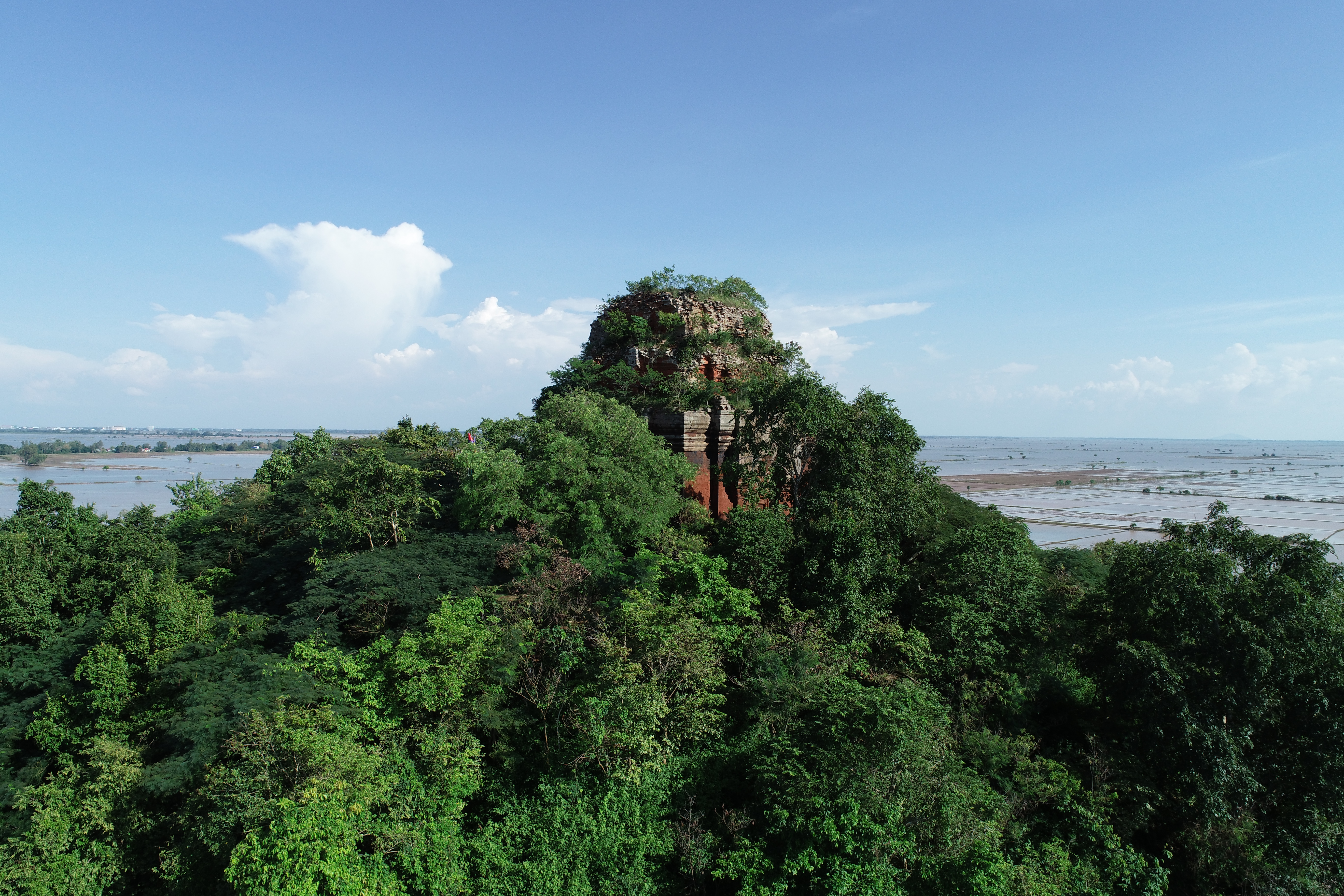In 1973, the Cleveland Museum of Art (CMA) acquired a fragmentary masterpiece of pre-Angkorian Khmer sculpture of Krishna Govardhana. Carved from a monolithic block of sandstone about 1,500 years ago, it depicts the young Hindu god Krishna in the superhuman act of holding aloft a low mountain. It comes from a cave at the top of a small granite outcrop, Phnom Da (Stone Mountain), in southern Cambodia near the ancient capital of Angkor Borei.
The Sanctuaries of Phnom Da
The sanctuaries of Phnom Da are recorded as the earliest monumental Hindu temple complex in Cambodia from surviving Khmer and Sanskrit inscriptions during the reign of King Rudravarman (514-539). The site also houses the earliest surviving Khmer stone temple dating to the 6th century. The caves on Phnom Da seem to have been first visited in the 1880s by a French civil servant. The next record comes from the archaeologist Henri Parmentier (1871-1949) of the École française d’Extrême-Orient (EFEO) in the report of his visit in June 1911.
The extensive sculptural finds from Angkor Borei and the nearby sacred sites of Phnom Da depict a wide range of Hindu and Buddhist imagery, probably based on descriptions in texts brought from India with Hindu priests and Buddhist monks. Sandstone as a medium for sculpture rose to prominence in the 500s, and within a century, Cambodian artists in Angkor Borei developed exceptional stone-carving skills and a local style widely celebrated for its power and sensitivity.
Adolphe Stoclet and Khmer Art
However, this particular story begins in 1920 with Adolphe Stoclet (1871-1949) and his wife Suzanne. They purchased many Khmer fragments, including the limbless head and torso section of a Krishna Govardhana sculpture from Phnom Da, as part of the frenzy of collecting to fill their new grand residence in Brussels, designed by Josef Hoffman and the Wiener Werkstatte. By 1937, many more Khmer fragments entered the Stoclet Collection via a French architect and conservator, Henri Mauger, who was then working in Cambodia, including what has become CMA’s Krishna Lifting Mount Govardhan.
Installed in their mansion, the Stoclet Palace, it achieved renown throughout the art world as a masterpiece of early Cambodian art. In 1935, Henri Mauger (1903-?) of the (EFEO) found 14 further sandstone fragments of arms, legs, feet, and a hand near the caves on Phnom Da. Believing that they included the pieces to complete their statue, the Stoclets arranged for the fragments to be shipped to Brussels. Dissatisfied with the appearance after multiple attempts to attach limb fragments to the torso at the home of their neighbour, sculptor Marcel Wolfers (1886-1976), the Stoclets abandoned the project. When new owners moved into the Wolfers’s villa, they used the stone fragments to support a new underground cistern and to edge the flower bed, where they remained unnoticed until the 1970s.
The Cleveland Krishna
Back in the US, in 1973, the Cleveland Museum of Art purchased the head and torso section of the Krishna Govardhana sculpture from the Stoclet estate. The Cleveland Krishna, an incarnation of Vishnu, is believed to be from a cave temple halfway up the northern slope of Phnom Da and is one of the five two-armed heroic figures of Phnom Da and one of two depicting his elevation of Mount Govardhan
Four years later, CMA curator Stanislaw Czuma managed to locate the buried fragments and transfer them to Cleveland. Conservators used eight of the pieces to create as complete a figure of the Krishna Govardhana as possible, and this elegantly restored sculpture was a centrepiece in the CMA galleries for nearly 40 years. In 2005, the Cleveland Museum of Art transferred the nine unused pieces to the National Museum of Cambodia in Phnom Penh. Conservators there attached six of the pieces to another limbless Krishna Lifting Mount Govardhan figure that was brought from Phnom Da in 1944.
From 2014 to 2018, following increased communications between curators and conservators in Cleveland and Phnom Penh, Bertrand Porte with the EFEO and SOK Soda of the National Museum of Cambodia recognised that the disposition of the fragments required further adjustments. Using 3-D modelling, CT scanning, and extensive analysis of stone samples, a team of scholars and specialists from Cambodia, France, and the US worked cooperatively to determine which fragments belonged with which sculpture.
This latest exhibition aims to reveal the context, history, and myth of the Cleveland Krishna Govardhana as understood today. Four digital galleries present the riverine landscape where it was made, its global travels and restorations – and life-size three-dimensional projections of all eight monumental stone sculptures from Phnom Da, and the role of geopolitics and museums in their discovery and conservation are in the show. In two sculpture galleries, the Cleveland Krishna is reunited with contemporaneous works from the same region for the first time in centuries (there are eight main sculptures and main sanctuaries at Phnom Da).
As revealed in these many years of examination, two of the pieces that were in Phnom Penh actually belonged with the Cleveland Krishna, and six of the pieces that were in Cleveland belonged to the Phnom Penh Krishna. Cleveland conservators then completed the arduous, delicate process of disassembling the 1978/79 restoration.
In 2020, the unprecedented exchange of sculptural fragments between the US and the Cambodia led to the latest reconstruction of both Krishna Lifting Mount Govardhan sculptures in 2021. Though neither sculpture is complete, they are now reunited with their correct fragments.
Until 30 January, 2022, Cleveland Museum of Art, clevelandart.org . A catalogue accompanies the exhibition.
Events: 12 December, Behind the Scenes of Revealing Krishna; 23 January, 2022, How Krishna Became Vishnu; 23 January, 2022, Cambodian Classical Dance






